
© Remy Dubas
Sometimes a seemingly innocuous decision can have a life-changing impact. For Gilles Lecaillon, founder and CEO of Ecocean, that moment came 30 years ago. Then, as a marine science student at the University of Perpignan, he was searching for an internship when he entered a building with two staircases. One led down to a lab studying parasites; the other, to a team working on fish larvae. He went up.
That choice led him to the Centre for Island Research and Environmental Observatory (CRIOBE), where he studied larval fish. At the time, they worked on life strategies of different fish species and found that, for many, only 1 percent survived to adulthood. It was there that a colleague posed a simple yet transformative question: “Since there are so many fish larvae in the ocean – and most won’t survive – why not collect them at this stage, rather than waiting until they’re adults?”
The question reframed how Lecaillon viewed ocean resources. If collected sustainably, these post-larvae could offer an alternative to the destructive practices being used to collect fish for aquaria.
“A large portion of the marine fish for aquariums were – and still are – caught using cyanide or targeted specific colourful species. Back then, it was estimated that for every fish that reached the customer alive, nine others had died,” recalls Lecaillon.
Lecaillon spent years testing post-larval capture in French Polynesia and Mayotte before founding Ecocean in France in 2003. The initial goal was to serve the ornamental fish trade using post-larval capture and culture (PCC), but that changed in 2008, with the introduction of the EU Marine Framework Directive, which emphasised the protection of marine biodiversity and achieving Good Environmental Status. This policy shift aligned more closely with conservation goals, prompting Ecocean to pivot from ornamental trade to ecological restoration.
“I was still doing the same job, but with a completely different goal. This time, the objective was not to supply fish for aquariums, but to restore natural ecosystems. From 2008 till 2012, I transitioned from the ornamental fish market to ecological engineering,” says Lecaillon.
In 2012, Ecocean had just three employees. Today, the team has grown to 18. The company’s original technique (now branded as BioRestore) remains central to its mission and has been continuously refined. Meanwhile, Ecocean has also developed other tools for marine restoration, including BioHuts, artificial reef-like fish nursery structures deployed in over 100 ports worldwide, and online books that describe species in details.
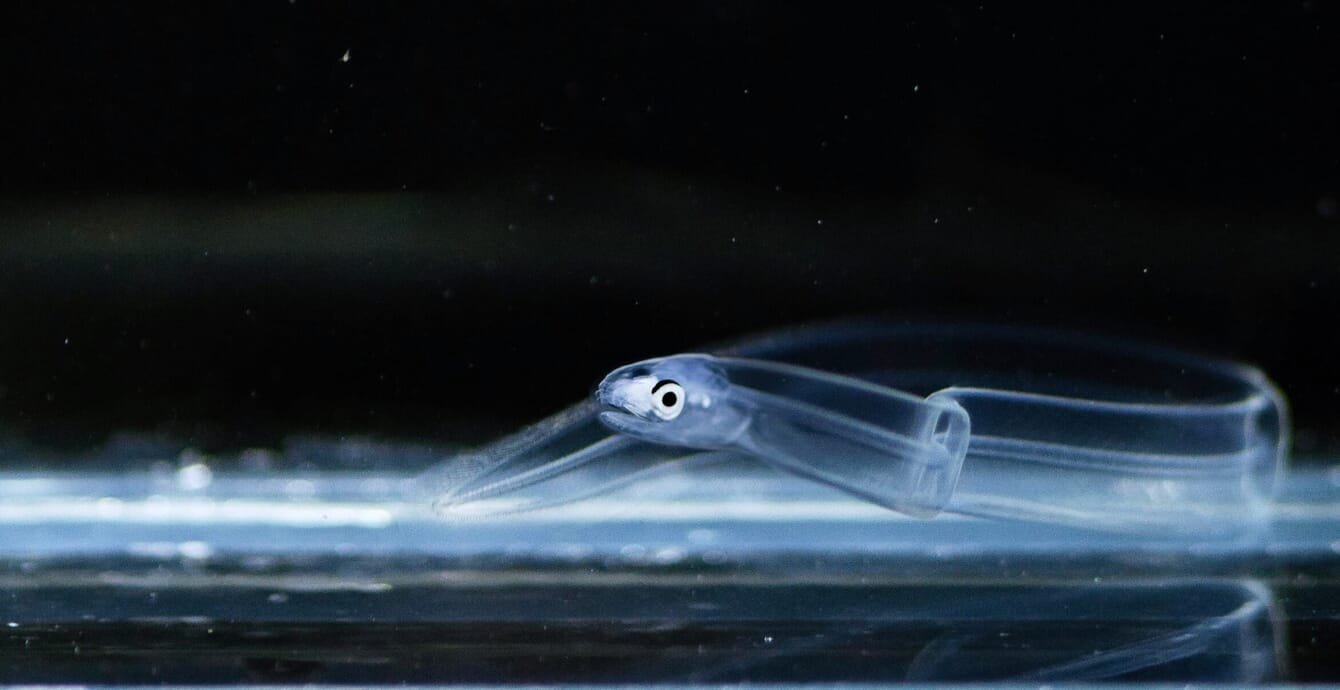
Pictured: a conger eel © Antony Fortin
Rebuilding ecosystems with post-larval capture and rearing
Wild post-larvae capture, culture and release (PCCR) is an innovative method of fisheries enhancement. It involves capturing naturally occurring fish larvae using specially designed light traps, rearing them in controlled conditions for four to six months – until they are large enough to evade predators – and then releasing them back into the wild.
Unlike aquaculture-based enhancement, which typically uses domesticated broodstock and can pose risks such as genetic pollution, PCCR works with wild individuals already present in the ecosystem. When conducted responsibly, it has minimal ecological impact and offers a promising tool to support recruitment in areas affected by human infrastructure such as ports, canals and offshore wind farms.
Ecocean’s traps, which are deployed by local fishers, are optimised for gentle capture. The Collection by Artificial Reef – Ecofriendly (CARE) trap is a floating, illuminated device that mimics a coral reef, attracting phototropic post-larval fish at night. Drawn to the light and seeking shelter, the larvae enter the trap voluntarily, reducing stress and physical damage.
“The capture systems used in 1998, when I started, were quite harsh for post-larvae. So, I developed a gentler technique using light. The larvae choose to enter the trap. They are attracted to the light, and since algae or debris aren’t, our traps stay clean,” explains Lecaillon.
Once reared, the fish are released using carefully refined protocols. Rather than releasing them directly from boats – which often led to high predation – Ecocean now relies on diver-led releases. Fish are held overnight under a submerged net tent to acclimate to local conditions.
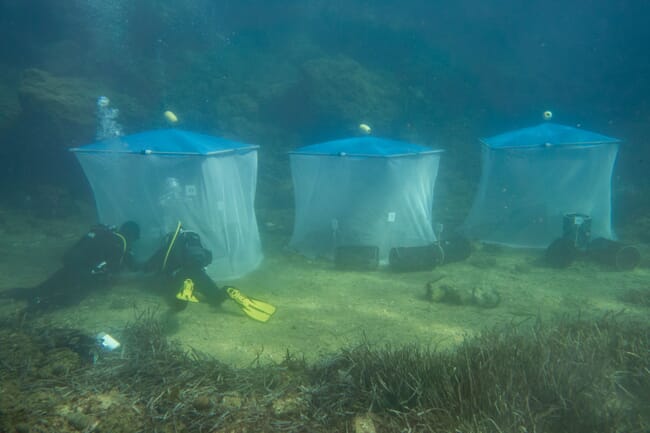
© Mathis Bizzari
“The first night is crucial. They reacclimate to the sounds, smells and feel of the natural environment,” details Lecaillon.
He’s also observed a remarkable instinctive response during releases.
“These fish have never seen the habitat we release them into. Their parents laid the eggs, and the larvae drifted offshore. Yet, as soon as we release them, they instinctively head into the corals – they immediately recognise it. You don’t see some fish figuring it out while others wait. They all behave like wild fish.”
Scientific studies have validated the approach. In France, tracking and modelling have shown that PCCR can significantly boost survival. For example, the early survival rate of white seabream (Diplodus sargus) – typically 1 to 35 percent in the wild – increases to 79 percent with PCCR intervention.
Unconventional aquaculture
Ecocean operates a unique form of low-density aquaculture using compact recirculating aquaculture system (RAS) units housed in shipping containers. While some elements mirror conventional practices – such as water filtration and temperature control – the scale and philosophy behind the system are fundamentally different.
“In standard aquaculture, they aim for 100 kg [of fish] per cubic metre. We are nowhere near that – we are at 200 to 300 grams [of fish] per cubic metre. So, we don’t need large volumes,” explains Lecaillon.
The process begins when captured post-larvae, weighing just 0.1 grams, are placed in transparent 20-litre tanks for about a month. This initial phase allows Ecocean to monitor health and verify species identity. Afterwards, the fish are transferred into larger, opaque tanks (200–300 litres) to reduce visual stimuli and minimise domestication.
Fish are reared in mixed-species groups – excluding predators, of course – and fed at random intervals to discourage routine dependency.
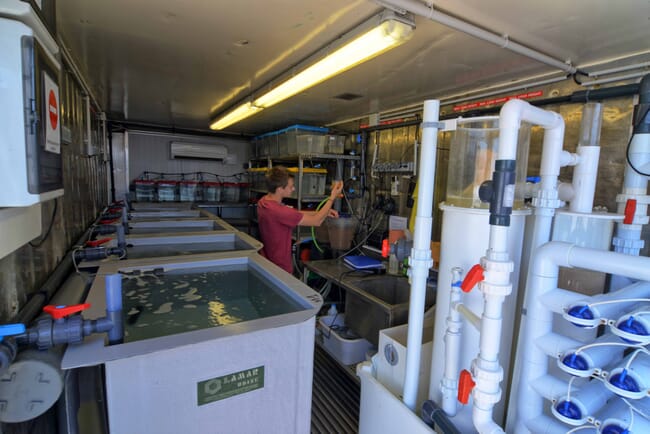
© Remy Dubas
Initially, all fish receive artemia, but they are quickly transitioned to more varied and growth-focused diets. This includes by-catch like krill and shrimp, live zooplankton, microalgae and formulated larval feeds.
Over time, the team has uncovered unique feeding behaviours that require species-specific adjustments. For example, it took trial and error to determine that striped red mullet (Mullus surmuletus) would only feed properly if food was buried in sand.
Before release, fish are moved into larger 500 to 1,000-litre tanks. Here, the focus shifts from feeding to wild training.
“As they grow older, they don’t need to eat every day. Sometimes, in a tank of 300 individuals, we will drop in 10 live shrimp – so not everyone eats. They quickly learn: if they don’t hunt, they don’t eat. That’s deliberate,’’ says Lecaillon. “We are training them for the wild. All of this is critical.”
While Lecaillon might make it sound simple, he explains that developing suitable protocols was a painstaking process.
“I’m summarising 15 to 20 years of research. This did not happen overnight – we made a lot of mistakes along the way,” he concedes.
Rebuilding wild populations from Marseille to Angola
Located in the western Mediterranean basin – a recognised biodiversity hotspot with more than 350 fish species – Marseille was the launch site for Ecocean’s first BioRestore project. Initiated with a mix of public and private funding, the programme is still active ten years later.
Other long-term collaborations have followed. In the Toulon region, Ecocean partnered with large infrastructure companies, including Veolia, to link marine restoration with environmental management. One example was a wastewater treatment plant that also supported fish restocking as part of its ecological offset strategy.
As BioRestore gained international visibility, Ecocean tested its model in over 30 countries – conducting feasibility studies and gaining experience with local species and environmental conditions. Among these, the Philippines stands out as the first country outside France to successfully implement a full BioRestore programme, managed by Sulubaai Environmental Foundation and supported by a foundation funded by the Fond Francais pour Environment Mondial (FFEM), The prince Albert 2 de Monaco Foundation and the Blancpain company.
“It’s been running for three years. In fact, I got a text this morning saying, ‘Hey, we just released 200 fish.’ We like to stay informed about everything happening on the ground,” explains Lecaillon.
Exporting the BioRestore project to the Philippines came with logistical challenges. Since Ecocean was unable to ship its fully equipped container system due to local restrictions, the team had to build the rearing facility from scratch.
A new project is also underway in Angola, where Ecocean is working to establish the system with the support of various funding sources. This financing allows the team to employ local fishers and aquaculture workers to help deploy the model on site. However, funding remains one of the main barriers to the broader development of the project, both in Angola and in other regions where similar efforts could be launched.
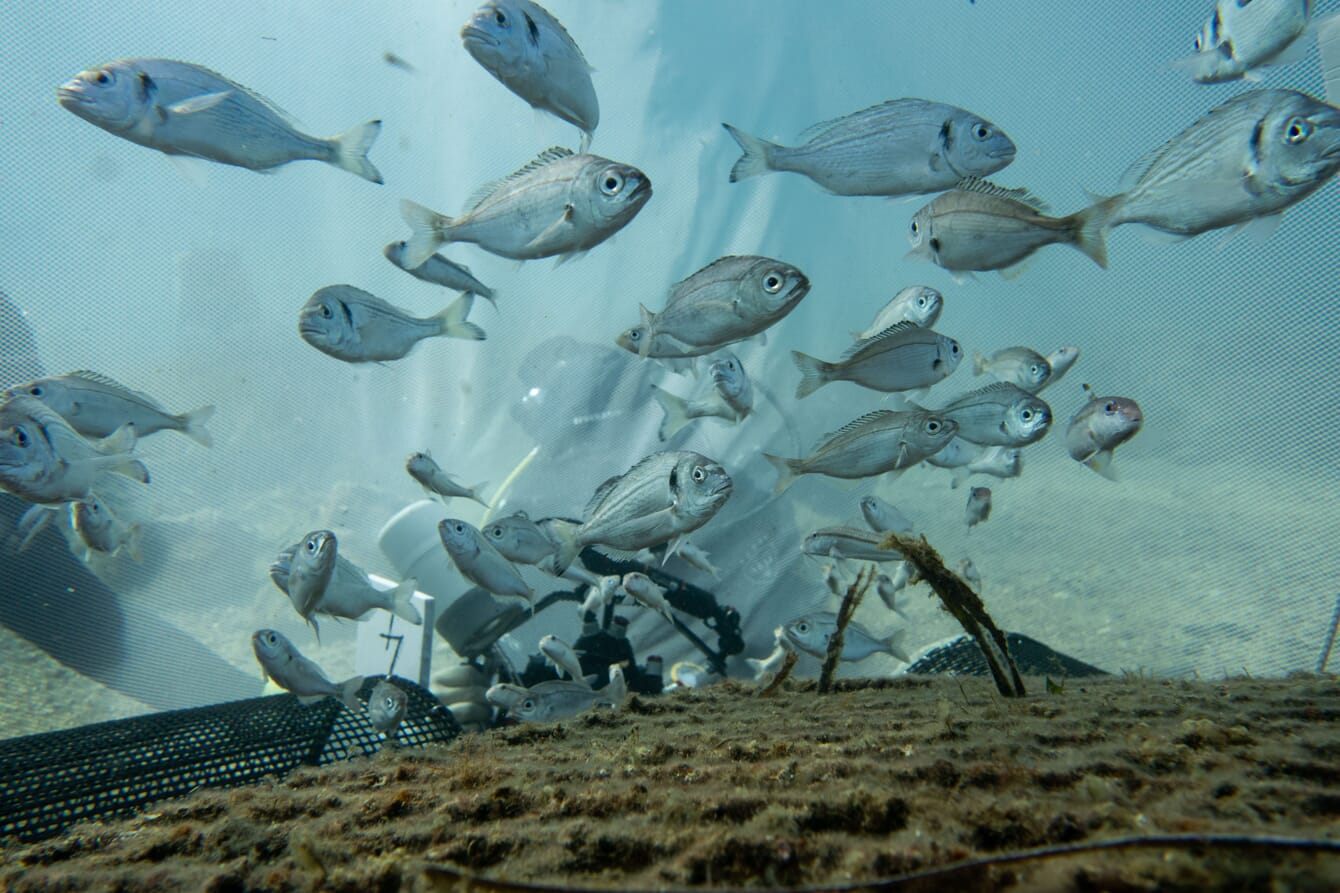
© Mathis Bizzari
The hidden costs of PCCR
Unlike conventional aquaculture, PCCR doesn’t generate immediate revenue – no fish are sold, and the economic benefit is harder to quantify. A cost-benefit analysis suggests that while the net gains may become clear within 8 to 10 years, there are also positive short-term impacts for fisheries, fishers, supply chains and regional economies.
“Fish move. For example, a seabream can travel 300 km in two or three days. Our work benefits the Mediterranean, but seeing a direct local gain is difficult. If I release 30,000 fish in Marseille, which might represent 150,000 over time as they reproduce, they are not all staying in Marseille. Many are spreading throughout the Mediterranean, and they can go to Morocco – we’ve demonstrated this with tags,” says Lecaillon.
This dispersed benefit can make it challenging to convince stakeholders to invest in projects whose results extend beyond their own territory. Long-term ownership is another issue. An award-winning project funded by the Grand Port Maritime of Guadeloupe was halted after just 2 years, leaving its container facility unused.
“Salaries are great, but who profits long-term? No one directly. So it’s hard to sell. In aquaculture, you buy a seabass at €0.70, you sell it for €2.50 – you make money. Our technology is scientifically validated, creates jobs, has no ecological impact, but the drawback is that the beneficiary is the common good,” explains Lecaillon.
A natural partner for aquaculture
Throughout his career, Lecaillon’s work has intersected with aquaculture – highlighting a complementary relationship between PCCR and conventional farming systems.
“We worked with Americans in Florida who wanted to breed snapper (Lutjanidae) but they did not know which species to choose as they didn’t know the growth rates. Because we had collected larvae there, we had four or five snapper species larvae. So, we helped them by growing the fish and observing their growth, helping to identify which species to focus on,” says Lecaillon.
While Ecocean typically restocks all captured larvae into the wild, there have been context-specific exceptions. In the Philippines, for example, traps frequently catch large numbers of rabbitfish (Siganidae) – a locally appreciated species. A portion of these are instead distributed to local communities for subsistence farming in small, non-intensive cages – supporting food security while avoiding industrial-scale production.
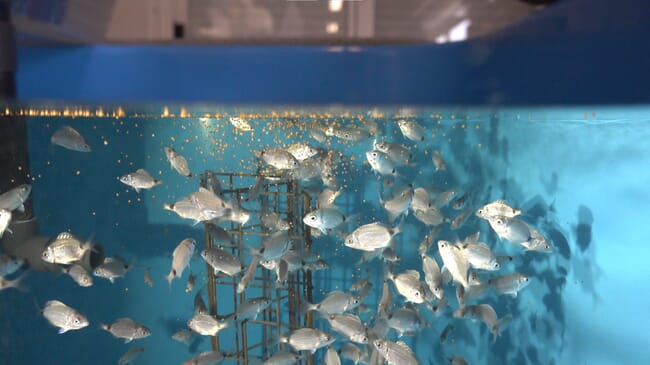
© Mathis Bizzari
Looking ahead: scaling science into policy
Ecocean’s growth has largely come through the persistent advocacy of Lecaillon and his team – an effort that’s now paying off. The company currently generates around €1.5 million in annual revenue and continues to scale its impact.
“Right now, I have three active BioRestore projects – but I could have 300 if there was sufficient funding,” says Lecaillon.
One of Ecocean’s emerging strategies involves partnering with offshore wind farm developers, who often displace fishermen, creating social and economic tensions. Ecocean offers a practical response: developers can support long-term fish restocking efforts in the very areas where fishing is now restricted. By funding local fishers to collect post-larvae and contribute to ecosystem restoration, these companies can actively mitigate their impact.
The estimated cost, around €3 million per wind farm over 10 years, is modest compared to the billions invested in offshore wind infrastructure.
Lecaillon is optimistic, particularly with the introduction of the new 2024 EU directive on ecological restoration. The regulation sets legally binding targets to restore at least 20 percent of degraded ecosystems by 2030 and aims to progressively recover all damaged habitats – from marine ecosystems and wetlands to forests, farmland and urban zones – by 2050.
“Going forward, we will be dealing with clients who have to act. They won’t be doing it just because it's nice – they will be required to. So, we are on the verge of something much bigger,” concludes Lecaillon.



